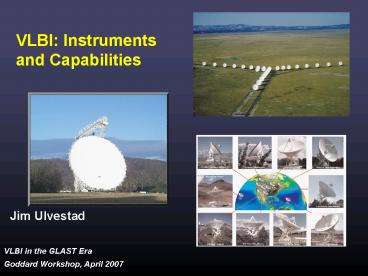VLBI: Instruments and Capabilities - PowerPoint PPT Presentation
1 / 20
Title:
VLBI: Instruments and Capabilities
Description:
Wide range of frequency bands, 0.3-86 GHz, frequency agility ... Nearby, low-luminosity AGNs may be a GLAST 'sleeper' Mrk 421, 501. M87, N4151. Nearby GRBs? ... – PowerPoint PPT presentation
Number of Views:44
Avg rating:3.0/5.0
Title: VLBI: Instruments and Capabilities
1
VLBI Instruments and Capabilities
- Jim Ulvestad
2
Outline
- Introduction to VLBI Arrays
- Strengths of Different VLBI Arrays
- Angular Resolution and Science Examples
- VLBI Evolution, 2007-2012
- Programmatic Considerations
3
Very Long Baseline Array
- http//www.vlba.nrao.edu
- Worlds only dedicated astronomical imaging array
- U.S. National Science Foundation/NRAO
- 10 dedicated 25m antennas
- Strengths
- Year-round availability, dynamic scheduling
- Wide range of frequency bands, 0.3-86 GHz,
frequency agility - Common calibration, repeatable aperture coverage
- Simple operations
- Weaknesses
- Small dishes and limited bandwidth
- No eVLBI capability
4
European VLBI Network
- http//www.evlbi.org
- Operated by national agencies in Europe
- Antennas of different sizes and capabilities
- Strengths
- Some large apertures, and higher bandwidth
- Sensitive short/intermediate spacings
- eVLBI capabilities
- Handy sensitivity calculator for mixed arrays!
- Weaknesses
- Fixed observing schedules
- Sessions limited to lt 10 weeks/yr
- Non-uniform antenna capabilities
- High-frequency capabilities limited
- Yebes, Sardinia telescopes will help
5
Other Northern Arrays
- High Sensitivity Array (HSA)
- http//www.nrao.edu/hsa
- Combines VLBA with GBT, VLA, Arecibo, Effelsberg
- Increased sensitivity, loss of flexibility
- Global VLBI
- Essentially combines European VLBI Network and
HAS - Long baselines, excellent sensitivity
- Poor flexibility, difficult calibration
- Global MM VLBI Array
- VLBA, Effelsberg, Onsala, IRAM, Metsahovi
- 3mm sensitivity still limited
- VERA Japanese 4-element network
- KVN Under construction in Korea
6
Australian Long Baseline Array
- http//www.atnf.csiro.au/vlbi
- Mix of telescopes, most baselines lt 1000 km
- 1 week block schedules, several times per year
- Frequencies up to 22 GHz
- Strengths
- Only Southern Hemisphere array
- eVLBI development
- Weaknesses
- Low availability
- Mix of telescopes
- Paucity of long baselines
7
Arrays of Choice
- Frequent monitoring VLBA
- High frequencies (22-43 GHz) VLBA, HSA, EVN
- High sensitivity EVN, HSA, Global VLBI
- Astrometry VLBA, HSA, EVN
- Southern Hemisphere ALBA, (VLBA)
- Real time EVN
- 3mm (86 GHz) VLBA, GMVA
- Highest resolution Space VLBI (see below and
Kellermann talk)
8
Angular Resolution of VLBA
9
Resolution for Distant AGNs
- Can distinguish motions and changes on scales as
small as 0.1 resolution elements - Superluminal motion enables changes in small
fraction of GLAST lifetime
10
Requirements for Imaging Blazar Jets
- High-frequency capability (gt 20 GHz) to image
jets where they are optically thin - Full-polarization imaging
- Dynamic scheduling for response to gamma-ray
flares at any time of year, and for repeated
reliable observations - Sub-milliarcsecond resolution to detect changes
on time scales of days to months - Only the VLBA meets these requirements
11
Resolution for Nearby AGNs
- At a distance of 20 Mpc, resolution of 0.02 to
0.1 pc is achievable - Nearby, low-luminosity AGNs may be a GLAST
sleeper
Mrk 421, 501
M87, N4151
Nearby GRBs?
12
Angular Resolution of VLBA
- VLBI resolution typically is about 1000-10,000
Schwarzschild radii - A few exceptions in the range of 100
Schwarzschild radii
13
VLBI Core of NGC 4151
- NGC 4151 was an OSSE hard X-ray source many years
ago - 15 GHz VLBI image at the right used
VLBAVLAGBTEb (Ulvestad et al. 2005)
14
A Gratuitous Viewgraph
- Dont forget about VLBI for galactic science
associated with GLAST! - Microquasar imaging and motions
- Pulsar parallaxes
- Distances to star-formation regions
- Colliding-wind binaries
15
VLBI Developments, 2007-2012
- European VLBI Network
- New 40m antenna in Yebes, Spain
- New 64m antenna in Sardinia, Italy
- New antennas in China
- Increased high-frequency capability
- Further eVLBI development, higher bandwidth
- Construction of Korean VLBI Network
- VLBA High-Sensitivity Project
- Increase data rate by factor 16 by 2010, thus
increasing sensitivity by factor of 4 - 22 GHz amplifier upgrade, 40 improvement in 2007
- 43 GHz amplifier upgrade proposed for 2008
16
NRAO/Haystack Digital Back End4 Gbps
17
Space VLBI (see Kellermann talk)
- Radioastron
- Scheduled launch, 2008-2009
- Very high orbit
- Poor imaging capability, exploratory at long
baselines - Has not met predicted launch dates in the past
- VSOP-2
- Scheduled launch, February 2012
- 10m antenna in imaging orbit, 1 Gbps
- 8, 22, 43 GHz
- ARISE and iARISE (ARISEVSOP-2) not under
development
18
Programmatics Senior Review
- NSF Senior Review praised VLBA uniqueness and
capabilities for GLAST support - But, Senior Review recommended that NSF pay only
3M of 6M direct costs of VLBA by 2011, or VLBA
should be closed - Necessitated by cost of new developments (GSMT,
LST, SKA) and ALMA operations - ALMA operations costs hitting NSF before 2011
- NRAO plans to be successful at finding scientific
and financial partnerships - This may well result in reduced flexibility and
reduced astronomical observing time available for
GLAST
19
Programmatics NRAO/GLAST MOU
- NRAO making available up to 10 of NRAO telescope
time for collaborative GLAST observations during
Cycle 1 - Includes VLBA, VLA, and GBT
- Hence, includes NRAO part of High Sensitivity
Array - Two proposal mechanisms
- Multiwavelength science, up to 200 hours of NRAO
time, directly through Cycle 1 call - Large proposals (gt 200 hr) and Targets of
Opportunity via direct proposal to NRAO
20
Summary
- VLBI observations are critical for GLAST to
succeed in achieving its scientific potential - Worlds VLBI observatories have a variety of
capabilities that will be useful for GLAST
science - Astronomical VLBI is supported by several
different ground-based research organizations,
not by NASA - ? Partnerships are critical for GLAST success































